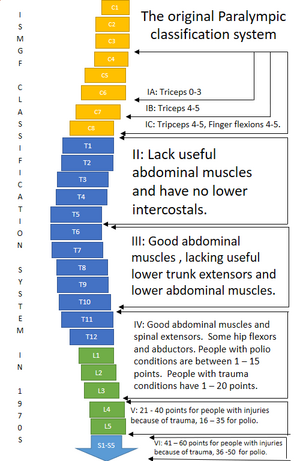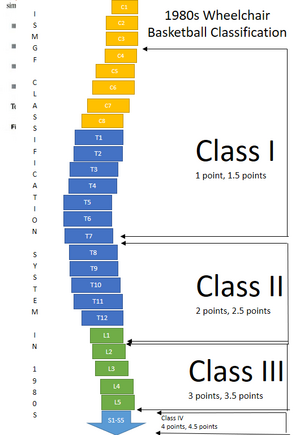Wheelchair basketball classification facts for kids
Wheelchair basketball classification is a special system that helps make games fair for everyone playing wheelchair basketball. It groups players based on how much they can move and control their bodies while in their wheelchairs. The different groups are called 1 point player, 2 point player, 3 point player, 4 point player, and 4.5 point player. The higher the number, the more movement and control a player has. The International Wheelchair Basketball Federation (IWBF) is in charge of setting these rules.
Contents
What is Classification?
Classification is super important in wheelchair basketball because it makes sure teams are balanced. Each player gets a certain number of points: 1, 2, 3, 4, or 4.5. A player with more points has more movement and control.
When five players are on the court, their total points can't be more than 14. This rule helps make sure that teams have a mix of players with different abilities, making the game exciting and fair for everyone.
Who Manages It?
The International Wheelchair Basketball Federation (IWBF) sets all the rules for classification in wheelchair basketball. The system used today was created by the IWBF in 2004.
Before that, in 1999, the United States had its own system because they thought the IWBF's rules were too complicated. However, the IWBF has always worked closely with other basketball groups while still making its own rules for wheelchair basketball.
Who Can Play?
To play wheelchair basketball, you need to have a physical disability that makes it hard to run, jump, or move quickly like someone without a disability. This disability must be permanent and can be checked by doctors.
Even people who have had a lower leg amputation can play. They are given a classification based on how well they can move and control their wheelchair.
History of Classification
In the early days, classification for wheelchair basketball was based on medical conditions. For example, at the 1968 Summer Paralympics, there were five classes (A, B, C, D, S), and each was worth a certain number of points. A team could have a maximum of 12 points on the court.
Over time, people started to think about changing the system. They wanted to focus more on what players could actually do (their "functional ability") rather than just their medical condition. This idea became a big discussion in the 1970s.
In the 1980s, wheelchair basketball was the first disability sport to switch to a functional classification system. This new system looked at how players moved and used their bodies in the wheelchair, not just their medical diagnosis. This change meant that players with amputations could also join the sport for the first time!
The new functional system was first shown at the 1983 Gold Cup Championships. It helped players feel more confident that they were being placed fairly. Even though the system was ready for the 1984 and 1988 Summer Paralympics, it wasn't officially used at the Games until 1992. This was because of some disagreements between different sports groups.
By 1992, the International Paralympic Committee (IPC) took over managing disability sports and their classification systems. This was also the first time that basketball players with different types of disabilities competed against each other. Players also got the right to appeal their classification if they thought it was wrong.
In 2003, the IPC decided to create an even newer classification system. This system, which started in 2007, focuses on things like muscle strength, missing limbs, and differences in leg length. The goal is to make classification even more fair and based on clear evidence.
How Players Use Points in Games
Sometimes, players might not fit perfectly into a whole number class. So, they can be classified as 1.5, 2.5, or 3.5 points. However, classifiers try not to give these "half-point" classifications right away.
Players with more points (like 4-point players) can move their wheelchairs much faster than 1-point players. They also tend to steal the ball more often and get more rebounds because they have an advantage in height, stability, and strength near the basket. However, 4-point players might also turn over the ball more often. Players with fewer points (like 1-point and 2-point players) usually handle the ball less during a game.
Since a team can only have 14 points on the court at one time, coaches can choose different strategies. For example, a team might have three 4-point players and two 1-point players. In this setup, the 1-point players might focus on setting screens (blocking opponents) while the higher-point players focus on scoring. Or, a team might choose a more balanced mix of players to have better overall movement and ball handling.
The Classification Process
If a player thinks their classification is wrong, they can appeal to the IWBF. During the classification process, players are often asked what classification they think they should have. Once a classification is given, it can only be changed if everyone who did the classification agrees.
In many countries, classification for national games is handled by the local Paralympic committee. For example, in Australia, the national sports group manages it with help from the Australian Paralympic Committee. There are different types of classifications:
- Provisional: For club-level games.
- National: For state and national games.
- International: For competitions around the world.
Paralympic Games and Classification
At the very first 1960 Summer Paralympics, only athletes in wheelchairs could compete in this sport. By the 1992 Summer Paralympics, players with amputations and cerebral palsy were also allowed to play. Classification at these Games was done by an independent group, focusing on how well players could move.
For the 2016 Summer Paralympics in Rio, the International Paralympic Committee had a rule that classifications should not be changed at the Games themselves. This rule started in 2014 to make sure athletes' training wasn't messed up by last-minute changes. All players needed to have their international classification confirmed before the Games.
The Future of Classification
The International Paralympic Committee is always working to make classification better. They want the system to be more based on clear evidence of a player's abilities, rather than just how well they perform in a game. This way, elite athletes won't be "punished" by being placed in a higher class just because they train a lot and are very good.



